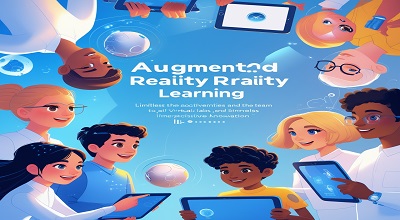Augmented Reality in Learning
Augmented Reality (AR) is revolutionizing the education sector by providing immersive, interactive, and engaging learning experiences. Unlike Virtual Reality (VR), which creates a completely artificial environment, AR overlays digital content onto the real world, enhancing the way students interact with educational material.
What is Augmented Reality (AR)?
Augmented Reality (AR) is a technology that superimposes digital elements—such as 3D models, animations, or informational text—onto the real world through smartphones, tablets, AR glasses, or other devices. Unlike Virtual Reality (VR), which requires a fully immersive headset, AR enhances the real environment with interactive digital overlays.
Key Features of AR:
- Real-time interaction
- Combines physical and digital worlds
- Enhances engagement and retention
- Accessible via smartphones and specialized devices
How Does AR Work in Education?
AR in education functions by using:
- Cameras & Sensors – To detect the real-world environment.
- Processing Software – To overlay digital content.
- Display Devices – Such as smartphones, tablets, or AR glasses.
Common AR Learning Methods:
- Marker-Based AR – Uses QR codes or images to trigger digital content.
- Markerless AR – Relies on GPS or object recognition.
- Projection-Based AR – Projects digital images onto physical surfaces.
Benefits of Augmented Reality in Learning
1. Enhanced Engagement
AR makes learning interactive, increasing student motivation.
2. Improved Retention
Visual and interactive content helps students remember concepts better.
3. Hands-on Learning
Students can manipulate 3D models, conduct virtual experiments, and explore historical sites.
4. Accessibility
AR apps can be used on smartphones, making them widely accessible.
5. Personalized Learning
Adaptive AR content can cater to different learning styles.
Latest Examples of AR in Education
A. AR in Science Education
- Google’s “Google Expeditions AR” – Allows students to explore 3D models of planets, cells, and dinosaurs.
- Froggipedia – An AR app that lets students dissect a virtual frog.
B. AR in History and Social Studies
- Civilizations AR (BBC) – Students can explore ancient artifacts in 3D.
- TimeLooper – Lets users experience historical events through AR.
C. AR in Mathematics
- GeoGebra AR – Helps students visualize geometric shapes in real-world settings.
- Math Alive! – Uses AR to teach basic math concepts interactively.
D. AR in Language Learning
- ** Mondly AR** – Offers virtual language lessons with interactive conversations.
- Word Lens (Google Translate AR) – Translates text in real-time using a smartphone camera.
E. AR in Medical Training
- Complete Anatomy (3D4Medical) – Medical students can explore human anatomy in AR.
- AccuVein AR – Helps nurses locate veins for injections using AR projections.
Challenges of Implementing AR in Education
Despite its benefits, AR in education faces challenges:
- High Costs – AR devices and software can be expensive.
- Technical Limitations – Requires stable internet and advanced hardware.
- Teacher Training – Educators need training to integrate AR effectively.
- Content Development – Creating high-quality AR content is time-consuming.
Future Trends of AR in Learning
1. AI-Powered AR Learning Assistants
AI will personalize AR experiences based on student performance.
2. AR Cloud-Based Learning
Cloud-based AR will allow seamless access to educational content.
3. Wearable AR Devices
AR glasses (like Microsoft HoloLens) will become more common in classrooms.
4. Gamified AR Learning
More AR games will be designed for educational purposes.
5. Collaborative AR Learning
Students will interact in shared AR spaces for group projects.
FAQs About Augmented Reality in Education
Q1: What devices are needed for AR learning?
A: Smartphones, tablets, or AR glasses (like Microsoft HoloLens).
Q2: Is AR expensive to implement in schools?
A: Initial costs can be high, but many free or low-cost AR apps are available.
Q3: Can AR replace traditional teaching methods?
A: No, AR is a supplement, not a replacement, enhancing engagement and understanding.
Q4: What subjects benefit most from AR?
A: Science, history, medicine, and mathematics see the most AR applications.
Q5: How can teachers integrate AR into lessons?
A: By using AR apps, interactive textbooks, and AR-based assignments.
Conclusion
Augmented Reality transforms education by making learning more interactive, engaging, and effective. AR provides endless possibilities for immersive education, from virtual frog dissections to exploring ancient civilizations. While challenges like cost and accessibility remain, the future of AR in learning is bright, with AI, cloud computing, and wearable tech paving the way for even more innovative applications.
Free Download: Super Brawl Universe APK
